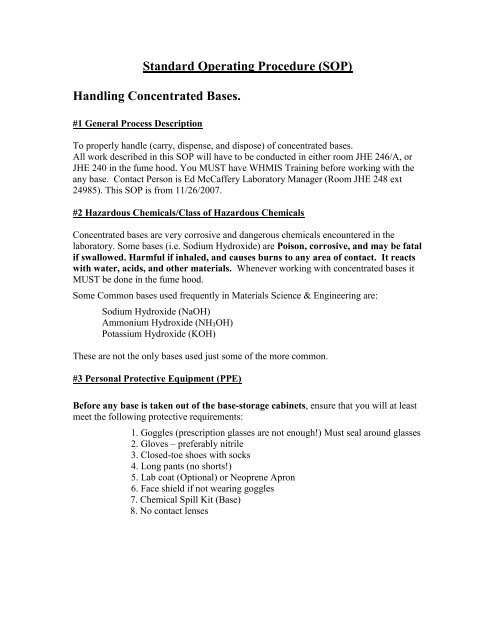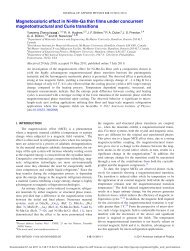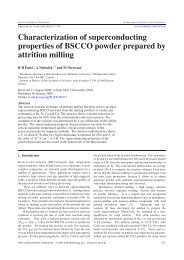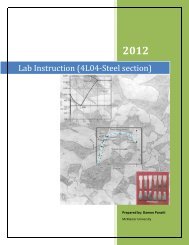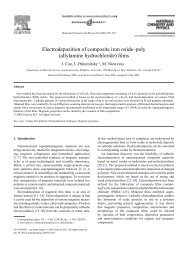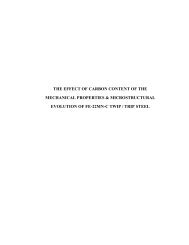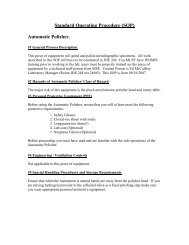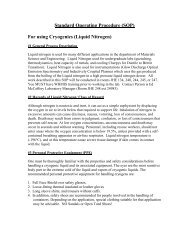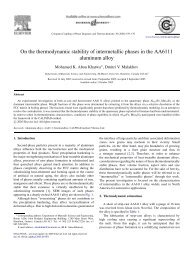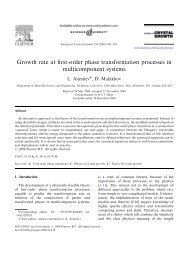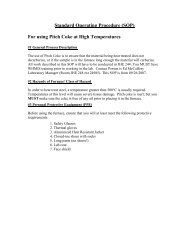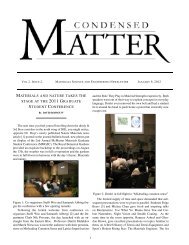Standard Operating Procedure (SOP) - McMaster Department of ...
Standard Operating Procedure (SOP) - McMaster Department of ...
Standard Operating Procedure (SOP) - McMaster Department of ...
Create successful ePaper yourself
Turn your PDF publications into a flip-book with our unique Google optimized e-Paper software.
<strong>Standard</strong> <strong>Operating</strong> <strong>Procedure</strong> (<strong>SOP</strong>)<br />
Handling Concentrated Bases.<br />
#1 General Process Description<br />
To properly handle (carry, dispense, and dispose) <strong>of</strong> concentrated bases.<br />
All work described in this <strong>SOP</strong> will have to be conducted in either room JHE 246/A, or<br />
JHE 240 in the fume hood. You MUST have WHMIS Training before working with the<br />
any base. Contact Person is Ed McCaffery Laboratory Manager (Room JHE 248 ext<br />
24985). This <strong>SOP</strong> is from 11/26/2007.<br />
#2 Hazardous Chemicals/Class <strong>of</strong> Hazardous Chemicals<br />
Concentrated bases are very corrosive and dangerous chemicals encountered in the<br />
laboratory. Some bases (i.e. Sodium Hydroxide) are Poison, corrosive, and may be fatal<br />
if swallowed. Harmful if inhaled, and causes burns to any area <strong>of</strong> contact. It reacts<br />
with water, acids, and other materials. Whenever working with concentrated bases it<br />
MUST be done in the fume hood.<br />
Some Common bases used frequently in Materials Science & Engineering are:<br />
Sodium Hydroxide (NaOH)<br />
Ammonium Hydroxide (NH3OH)<br />
Potassium Hydroxide (KOH)<br />
These are not the only bases used just some <strong>of</strong> the more common.<br />
#3 Personal Protective Equipment (PPE)<br />
Before any base is taken out <strong>of</strong> the base-storage cabinets, ensure that you will at least<br />
meet the following protective requirements:<br />
1. Goggles (prescription glasses are not enough!) Must seal around glasses<br />
2. Gloves – preferably nitrile<br />
3. Closed-toe shoes with socks<br />
4. Long pants (no shorts!)<br />
5. Lab coat (Optional) or Neoprene Apron<br />
6. Face shield if not wearing goggles<br />
7. Chemical Spill Kit (Base)<br />
8. No contact lenses
<strong>SOP</strong> – Handling Concentrated Bases.<br />
Before proceeding, you must have read and are familiar with the MSDS for each <strong>of</strong> the<br />
hazardous materials you will be using. All Material Safety Data Sheets (MSDS) are<br />
located in room JHE 248 top shelf East Wall.<br />
Ensure the spill kit is available in the event <strong>of</strong> an exposure. The base spill kit is located<br />
on the West Wall beside the door in room JHE-240. Do Not use the Acid spill kit to<br />
absorb a Basic spill.<br />
#4 Engineering / Ventilation Controls<br />
All work with concentrated bases must to be done in the fume hood, with no other<br />
persons working close enough to interfere or come into contact with the base; someone<br />
must be in the immediate area in case <strong>of</strong> an emergency, the protective shield on the fume<br />
hood drawn down as much as possible, but allowing to work comfortable. Make sure<br />
when you are dispensing the bases that the bottle being dispensed in is far enough in the<br />
fume hood so that fumes will not come back to the users face.<br />
#5 Special Handling <strong>Procedure</strong>s and Storage Requirements<br />
Store all basic waste in labeled chemically compatible containers (e.g., polyethylene or<br />
Teflon). Do not store in glass, metal, and ceramic containers, as they are not compatible<br />
with some bases.<br />
Store all concentrated bases containers in the base cabinets in its proper secondary<br />
containment tray. Bases are stored under the fume hood separate from the acids.<br />
Place a secondary containment tray in the fume hood, when handling and pouring<br />
concentrated bases. In case you overfill or spill the solution, it will stay in this secondary<br />
containment.<br />
No rinse water with pH above 9 may be drain disposed.
<strong>SOP</strong> – Handling Concentrated Bases.<br />
Please review the last page for emergency contact and notifications.<br />
#6 Spill and Accident <strong>Procedure</strong>s<br />
If you spill your solution and the spill is an immediate threat to your health, leave<br />
the room, call 88. Remain nearby. In the event <strong>of</strong> an exposure, follow “<strong>McMaster</strong><br />
University First Aid Instructions” posted in the labs.<br />
If you accidentally spilled concentrated base (e.g., while pouring a base into the<br />
measuring cylinder): Don’t panic! Remain calm. If the spill is minor (less than30mL,<br />
“note a 5 inch x 7 inch paper towel will absorb 5 ml <strong>of</strong> water”), and will not pose a health<br />
issue; use the spill-containment kit; pour the absorbent; first make a circle encompassing<br />
the spill then pour the absorbent on top <strong>of</strong> the spill. Find a plastic/neoprene-disposal<br />
bottle in room JHE 248 and carefully place the soaked absorbent into the bottle, and place<br />
in Chemical Waste label on the container. To minimize contact with the base during<br />
clean-up, use the small broom and dust pan to move the soaked absorbent into the bottle.<br />
All <strong>of</strong> this must be done in the fume hood.<br />
If the spill is significant; larger (> 30 mL), if the spill does not pose a health hazard;<br />
inform any other personal in the lab; then use the Basic spill-containment kit in room<br />
JHE 240 on the West Wall beside the door. Pour the absorbent around the spill then pour<br />
the absorbent all over the spill.<br />
If spill is greater than 30 ml, or cleanup takes longer than 15 minutes, document the<br />
cleanup activity either by calling EOHSS at Ext 24352 or by notating the lab inspection<br />
forms.<br />
IF THE CONCENTRATED BASE IS RUNNING OUT OF THE FUMEHOOD, place<br />
spill-containment absorbent on the spill and contact EOHSS at 24352 or call 88<br />
(Emergency) immediately and leave the laboratory making sure you notify any personal<br />
in that lab, but stay nearby to provide information to responders. DO NOT TRY to place<br />
the soaked absorbent into the neoprene bottle, as fume evaporating from the concentrated<br />
bases pose a serious health hazard. Contact Emergency Response (88), then Lisa Morine<br />
Ext 23314 and Ed McCaffery Ext 24895.<br />
If the spill runs underneath the fume hood, lab equipment, or if it goes down sink call<br />
EOHSS Ext 24967.<br />
If a fire breaks out because <strong>of</strong> the spill leave the area immediately, activate the fire alarm<br />
dial 88. Stay close to the building to inform emergency personal <strong>of</strong> what started the fire<br />
and what other chemicals are in the immediate area <strong>of</strong> the fire. There is a list <strong>of</strong><br />
chemicals on the Materials Science & Engineering Web site:<br />
http://mse.mcmaster.ca/SAFETY/<strong>SOP</strong>s/MSDS%20Chemical%20List.pdf
<strong>SOP</strong> – Handling Concentrated Bases.<br />
#7 Waste Disposal<br />
If you’ve spilled your basic solution and soaked up the basic solution using absorbent,<br />
make sure it is disposed into neoprene bottle (4L). These containers will be labeled with<br />
a Chemical Waste Label. Any waste are to be dispensed in the Chemical Waste Buckets<br />
located in the fume hoods. Any glassware used needs to be rinsed three times prior to<br />
washing.<br />
#8 Training requirements<br />
Prior to entering and working in the laboratory, you must have completed WHMIS<br />
training, Chemical Spills Training, Chemical Handling Training; you are required to also<br />
take Specific Workplace Training through EOHSS. You must have written and have<br />
signed the safety reports by your supervisor. After each year the safety report must be<br />
updated. Any person conducting work in rooms JHE-246/A or JHE-240 using this <strong>SOP</strong><br />
must receive training on the contents <strong>of</strong> this <strong>SOP</strong>.<br />
#9 Approval Required<br />
All research staff must have WHMIS Training; and Specific Workplace Training prior to<br />
starting work with concentrated bases.<br />
Always ask a second person to be in the lab with you when working with concentrated<br />
bases. If you have to work with concentrated bases and you are alone, you have to ask for<br />
approval from your supervisor and the Person In-charge, Laboratory Manager Ed<br />
McCaffery.<br />
#10 Decontamination<br />
All glassware and measuring cylinders that have been used during the process <strong>of</strong> mixing<br />
<strong>of</strong> basic solution should be thoroughly rinsed with Distilled water (3 times) and then soap<br />
and water (1 time). Collect first three rinseate as hazardous waste.<br />
#11 Designated Area<br />
Concentrated bases are only allowed to be handled in the fume hoods. Filling and rinsing<br />
<strong>of</strong> the bottles should only be done near a sink, but with secondary containment tray in the<br />
sink.<br />
Upon leaving a designated work area, remove any personal protective equipment worn<br />
and wash hands, forearms, face, and neck. After each use (or day), wipe down the<br />
immediate work area and equipment to prevent accumulation <strong>of</strong> chemical residue. At the<br />
end <strong>of</strong> each project, thoroughly.<br />
Decontaminate the designated area before resuming normal laboratory work in the area.
<strong>SOP</strong> - Handling Concentrated Bases.<br />
#12 Precise Process Description<br />
1. Verify that emergency eyewash/shower is accessible and tested within last<br />
month.<br />
2. Verify that fume hoods are currently certified and alarms are working.<br />
3. Check the location and expiration <strong>of</strong> the Base Spill Kit and that a copy <strong>of</strong> the<br />
MSDS for the concentrated base being used is available.<br />
4. You have read and understood the contents <strong>of</strong> this <strong>SOP</strong>.<br />
5. It is essential that you wear a face shield over your safety glasses, nitrile<br />
gloves (preferable), and the neoprene aprons to ensure proper protection<br />
for concentrated base spills.<br />
6. Most bases in the Materials Science and Engineering are made from salts.<br />
7. Weigh out the salt into a weigh boat using a digital balance. Wear gloves and<br />
safety glasses. Once the salt is weighed out take it back to the fumehood to<br />
add water.<br />
8. Mix the solution thoroughly in the fumehood, place any glassware being used<br />
to collect the base is in a secondary containment tray.<br />
9. Wash any glassware which was used with the base, rinse them 3 x with<br />
Distilled water, and collect the first three washes as hazardous waste.
<strong>SOP</strong> – Handling Concentrated Bases.<br />
Laboratory Spill Response <strong>Procedure</strong>s<br />
Health Threatening Situation - In the event <strong>of</strong> an imminent or actual health-threatening<br />
emergency (threatening local or public health, safety, or welfare; or the environment<br />
outside the immediate area):<br />
1) CALL 88 FOR THE EMERGENCY RESPONSE AND REMAIN IN THE AREA<br />
TO ADVISE RESPONDERS.<br />
2) ACTIVATE LOCAL ALARM SYSTEMS<br />
3) Once personal safety is established, call EOHSS at Ext 24352 and proceed with<br />
local notifications, below.<br />
Non-Health Threatening Situation – In the event <strong>of</strong> a spill or release which may or has<br />
impacted the environment (storm drain, soil, air outside the building) or spill or release<br />
that cannot be cleaned up by local personnel:<br />
1) Notify <strong>McMaster</strong> Responders: Call 88 (24 hours/day, 7 days/week), then<br />
2) Provide local notifications:<br />
Name Phone Number Title<br />
Ed McCaffery Ext 24985 Lab Manager/ Principal Investigator<br />
Lisa Morine Ext 23314 EOHSS<br />
Local Response Situation – In the event <strong>of</strong> a minor spill or release that can be cleaned<br />
up by local personnel using readily available equipment (absorbent, available from<br />
EHOSS in Spill Kit):<br />
1) Notify personnel in the area and restrict access. Eliminate all sources <strong>of</strong><br />
ignition.<br />
2) Wear gloves and protective eyewear. Clean up using absorbent. Put the<br />
contaminated absorbent in a labeled hazardous waste container.<br />
3) If greater than 30 ml, or cleanup takes longer than 15 minutes, make a<br />
record in your lab inspection report, or call 88 Emergency Response to record<br />
the spill, and notify your supervisor.<br />
4) Submit online waste pickup request to EHOSS at: waste@mcmsater.ca<br />
Disclaimer: The <strong>SOP</strong> as written contains our best understanding at this time on how to<br />
work safely with this piece <strong>of</strong> equipment. When new information is found that would<br />
improve the safe use <strong>of</strong> this equipment it will be added in a timely manner. As it stands<br />
we cannot be held liable for misuse or abuse <strong>of</strong> these instructions through negligence on<br />
the user’s part or based on the content <strong>of</strong> these notes.


